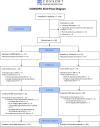Postnatal serum IGF-1 levels associate with brain volumes at term in extremely preterm infants
- PMID: 35681088
- PMCID: PMC9988684
- DOI: 10.1038/s41390-022-02134-4
Postnatal serum IGF-1 levels associate with brain volumes at term in extremely preterm infants
Abstract
Background: Growth factors important for normal brain development are low in preterm infants. This study investigated the link between growth factors and preterm brain volumes at term.
Material/methods: Infants born <28 weeks gestational age (GA) were included. Endogenous levels of insulin-like growth factor (IGF)-1, brain-derived growth factor, vascular endothelial growth factor, and platelet-derived growth factor (expressed as area under the curve [AUC] for serum samples from postnatal days 1, 7, 14, and 28) were utilized in a multivariable linear regression model. Brain volumes were determined by magnetic resonance imaging (MRI) at term equivalent age.
Results: In total, 49 infants (median [range] GA 25.4 [22.9-27.9] weeks) were included following MRI segmentation quality assessment and AUC calculation. IGF-1 levels were independently positively associated with the total brain (p < 0.001, β = 0.90), white matter (p = 0.007, β = 0.33), cortical gray matter (p = 0.002, β = 0.43), deep gray matter (p = 0.008, β = 0.05), and cerebellar (p = 0.006, β = 0.08) volume adjusted for GA at birth and postmenstrual age at MRI. No associations were seen for other growth factors.
Conclusions: Endogenous exposure to IGF-1 during the first 4 weeks of life was associated with total and regional brain volumes at term. Optimizing levels of IGF-1 might improve brain growth in extremely preterm infants.
Impact: High serum levels of insulin-like growth factor (IGF)-1 during the first month of life were independently associated with increased total brain volume, white matter, gray matter, and cerebellar volume at term equivalent age in extremely preterm infants. IGF-1 is a critical regulator of neurodevelopment and postnatal levels are low in preterm infants. The effects of IGF-1 levels on brain development in extremely preterm infants are not fully understood. Optimizing levels of IGF-1 may benefit early brain growth in extremely preterm infants. The effects of systemically administered IGF-1/IGFBP3 in extremely preterm infants are now being investigated in a randomized controlled trial (Clinicaltrials.gov: NCT03253263).
© 2022. The Author(s).
Conflict of interest statement
A.H. and C.L. hold stock/stock options in Premalux AB. In addition, A.H. and D.L. have received consulting fees from Shire, a Takeda company. The rest of the authors declare no competing interests.
Figures



References
Publication types
MeSH terms
Substances
Associated data
LinkOut - more resources
Full Text Sources
Medical
Miscellaneous

